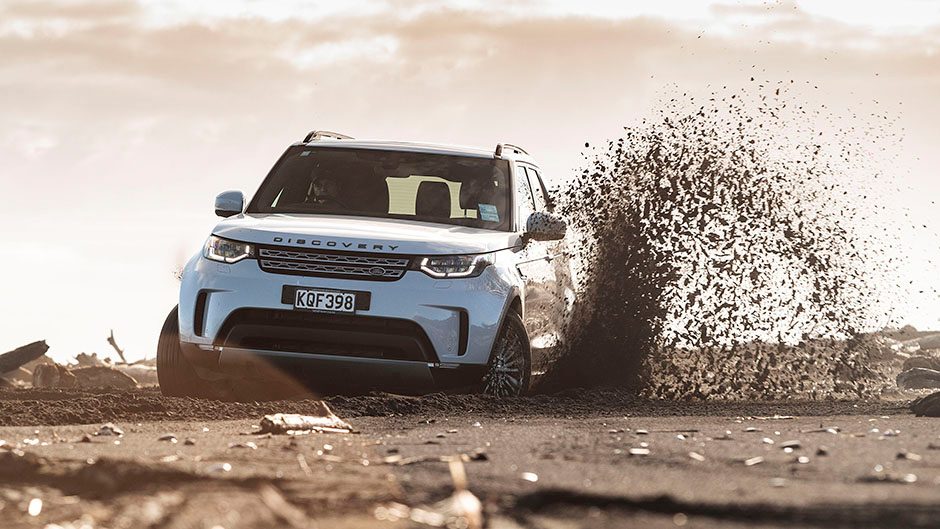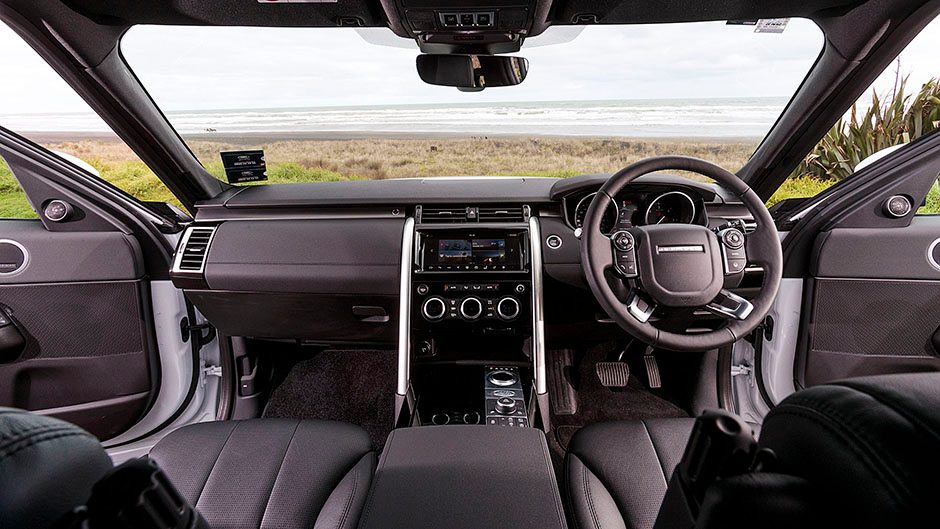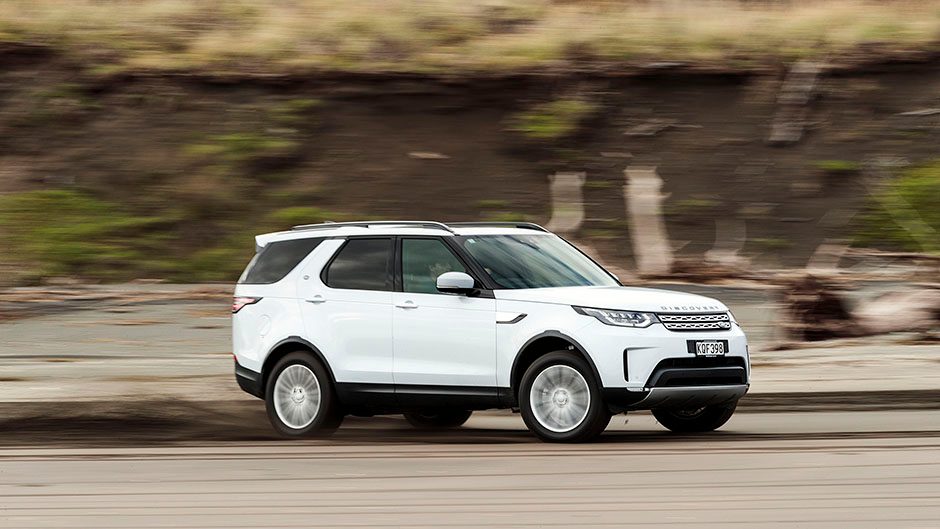Even if you’re the type to despise SUVs, it’s hard to argue against their versatility. Discovery brought some civility to Land Rover’s 4X4 offerings when it launched, the original utilising Range Rover underpinnings. It’s evolved over the decades, and though it’s always been a true 4×4, Land Rover has polished its manners and breeding to a point where the latest model could be considered the most versatile luxury vehicle you could aspire to.
Louisson gave the new Discovery a thorough rundown from its international launch a few months back, but for those who missed it, there are three variants starting at $114,900 for the SE, the HSE is $126,900 (on test) and the HSE Luxury is $136,900, each offering the choice of the 3.0-litre Td6, or the petrol supercharged Si6 at the same price. The design smoothes the boxiness of the previous gen and it’s now more slippery. Not everyone loved the look; the rear is probably the most contentious area with its asymmetric, one piece tailgate design. The stepped roof returns, allowing third row passengers plenty of headroom. Overall Discovery is longer, lower and slightly narrower. It’s now a monocoque design, using the firm’s aluminium-intensive underpinnings shared with the Range Rover, so it’s said to be stiffer and lighter. The last Disco4 we measured, the TDV6 SE, tipped in at 2610kg and this HSE is lighter but still hefty at 2475kg (2298kg the claim). The body panels are largely alloy while the subframes are steel for its added stiffness to improve steering and ride refinement. There are double wishbones up front with a multilink rear featuring the integral link design that lets the chassis tuners deliver better body control and enhanced steering when cornering but not at the cost of ride quality. The latter is enhanced with the standard air suspension.
The diesel engine is a revised 3.0-litre, single-turbo V6, with fewer emissions thanks to exhaust gas recirc, revised injectors and internal improvements. It fronts up with 190kW and 600Nm and again teams with the ZF eight-speed. There’s torque vectoring by brake to help cornering and more active safety features.

Versatile or what?
The Discovery is a machine for every occasion. It‘ll tow 3500kg, and go just about anywhere you dare to point a rig with a six figure price tag. The variable air suspension can ramp ground clearance up to a maximum of 283mm, giving half a metre of wheel articulation while it will lower itself to ease entry and exit. Low range can be activated on the move up to 60km/h and, with permanent AWD, torque is split 50/50 but is variable via the auto locking centre diff. Traction control systems keep you trucking slowly on extreme surfaces with the Terrain Response 2 gizmo setting the electronics to suit the ground travelled. We’ve driven Discovery up undulating slopes you’d struggle to walk up while the sand mode is excellent on the beach, keeping the engine lively while the ESP lets you get a slide on, coming in just in time to ensure you don’t overextend yourself.
Discovery will take seven troops too. With a flat floor and a middle seat that doesn’t feel like a plank of wood, three would fit across the second row while the two seats in the boot are designed to fit a humanoid up to 1.9m tall, providing room for heads, legs and feet too, though more seat padding would be appreciated. This HSE features the optional powered seat set-up with all seven seats featuring some form of electric adjustment, only the second row slider is manual. Pros include one touch folding, with switches in the boot area, on the C pillar and central touchscreen (even remotely via an extra cost app) for easy configuration, but it’s a slow process and hopefully it will all still work in five years’ time. While there’s a big load area behind the second row, (1231L expanding to 2500L when all the rear seats are folded flat) there’s minimal space left with all seats in use. Though Land Rover quotes 258L, the area is tight. They’ve included a novel tailgate inside the boot. The idea behind this fold down panel is that it helps stop things falling out of the boot when the door is opened, and then when lowered you have an ‘event seat’. But it’s not all that comfy to perch on, and we found it simply got in the way when trying to load and unpack. A smarter idea is a washer jet for the reverse camera. The rear of the Disco grimes over with road filth when it’s wet, and so when you wash the rear screen, a jet also cleans the camera lens.
The rear doors are big for ease of access, but problematic in tight car park. Still, it is good that all four doors extend over the sill, leaving it clean, along with your trouser leg when exiting. There is plentiful storage in the cabin with some novel solutions, some more useful than others, and hundreds of charge points, along with more connectivity function too, though most are optional extras. There’s a larger 10-inch touchscreen now with faster processing speeds and more options too like dual view screen (driver sees the nav map while passengers watch the tube). The interior should impress, being well finished and functional with a few luxury touches. Think of it as a more utilitarian Range Rover.

Better on road too?
The goals for the new Discovery included retaining its all-terrain ability, enhanced on-road dynamics, more refinement, comfort and added technology. And it ticks all those boxes for sure. It’s refinement stands out; road and wind noise are well suppressed, and the ride, no matter the terrain, is notable too, the air springs and solid subframes isolating the bumps.
As a commuter, the Discovery is big, but still manageable with audible and visual parking aids, the turning circle good, and the steering effort easy at a crawl. The lag time from the diesel is minimal, sometimes taking a moment more with the idle stop/start but otherwise there’s grunt galore, with the trip computer reading in the 11s for our mix of adventuring, cruising and commuting.
Given more of a work out, the V6 growls under acceleration and there’s even a rumble on a trailing throttle. The auto’s sport mode is selected with a further rotation of the gear knob, and this keeps the action hovering above 2500rpm to ensure a better response, the V6 beavering eagerly away up past 4200rpm. And as always the eight-speed auto knows just what cog to be in, with little need for the paddles.
The air springs handle the weight transition nicely in the bends but there’s no hiding the Discovery’s overall mass. It always feels substantial. However, it’s commendable that you can easily manage all that weight thanks to the response and feeling from the chassis controls. Yeah it’s big but not unwieldy and it steers sweetly. There’s substance to the helm’s weighting at speed and it’s free of any of those electric oddities like self centering or any iffy feel away from centre, and better yet, there’s a degree of feel for the action at the tarmac too. While it took the diesel just under nine seconds to move the mass to 100, you’re still able to pick-off the dawdlers safely, as it’s far from lumbering. Added technology comes with the now usual suite of driver aids; AEB, lane keeping (easily switchable) and blind spot monitoring, while the active cruise is easy to set and works in stop and go traffic too.

The competition?
Few can lay claim to the broad abilities of the Discovery, which does many things very well. The Land Cruiser 200 is closest in concept but is now a generation behind, while the rest are road-biased seven-seater crossovers. If you need a luxury rig that does it all, the Discovery does tick a lot of desirable boxes.
| Model | Land Rover Discovery Td6 SE | Price | $114,900 |
| Engine | 2993cc, V6, TDI, 190kW/600Nm | Drivetrain | 8A, AWD |
| Fuel Use | 7.5L/100km | C02 Output | 195g/km |
| 0-100km/h | 8.10sec | Weight | 2350kg |


